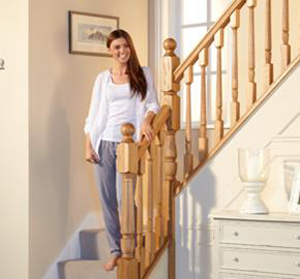| |
Know your Stairs at Wonkee Donkee Richard Burbidge
|
|
| |
|
|
Shop for Staircase Parts
|
|
| |
 |
|
| |
|
|
|
|
| |
 |
|
Your stairs are built to be safe and so are constructed in such a way as to ensure that there is no movement of their parts.
However, over time, things can change. Whether by normal wear and tear, physical damage or later modifications and alterations, your stairs may not be in the condition they were in when first installed.
|
|
| |
|
|
|
|
| |
 |
|
Over the years, legislation has tightened up to ensure that stairs are safe to use by all. The older your stairs, the less likely that they will conform to the current regulations. This affects the angle or 'pitch' of the stairs, the depth or 'go' of each tread, the height or 'rise' of each tread, as well as the size of gap in the balustrade or 'infill'. The tread width and the handrail height is also covered under the regulations, with differences between domestic and public installations.
|
|
| |
|
|
|
|
| |
 |
|
Some construction methods have changed over time for ease or speed of assembly, but traditional methods can still be employed.
Before you carry out any work on your stairs, it’s a good idea to get to know how your stairs are constructed. Not all stairs are constructed the same way, and many employ different methods of construction within the same staircase.
|
|
| |
|
|
|
|
| |
 |
|
Wonkee Donkee aims to increase your level of understanding of how stairs are built so that you can remodel yours with confidence, knowing that you’re not going to cause costly damage or have a detrimental effect on the structural integrity of your stairs.
When you are ready, browse our online catalogue of stair parts and feel free to contact us if you have any questions.
|
|
| |
|
|
|
|
| |
|
|
|
|
| |
|
|
|
|